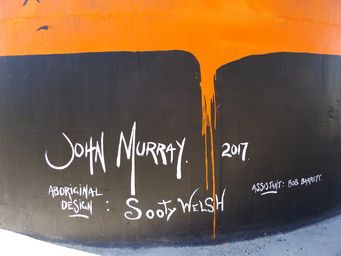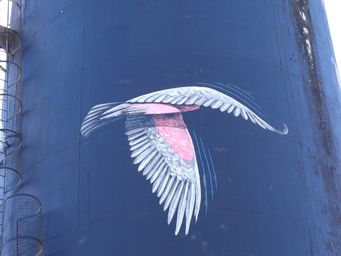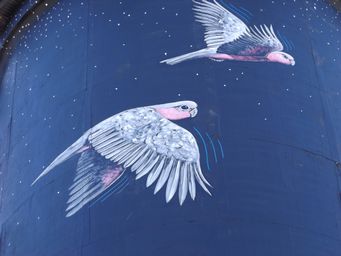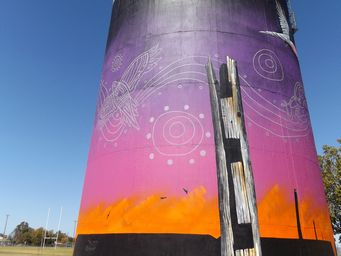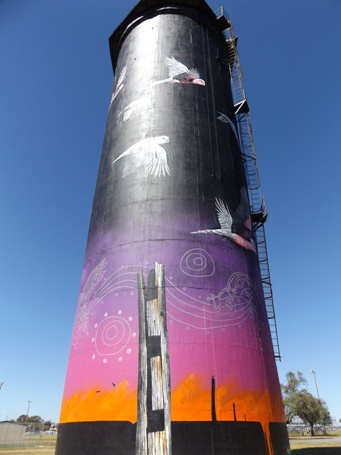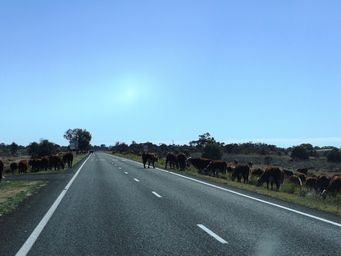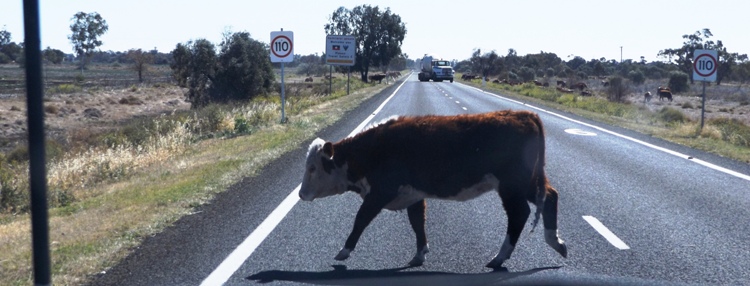Australia So Much to See
New South Wales - Quambone and Coonamble
At Coonamble, we visited the newly painted water tower at the sports ground, which is adorned with Galahs. Lightning Ridge artist John Murray, assisted by Bob Barrett, painted the water tower over 11 days in June 2017. Sooty Welsh designed and
painted the Aboriginal features.
At Coonamble we were less than fifty kilometres from Gulargambone, and it was tempting to consider paying the lovely Gulargambone
Caravan Park another visit, but this time we were heading north.
Grazing the Long Paddock. Not far north from Coonamble, the Castlereagh Highway was signed as 110 kilometre stock route. Soon we saw a large herd of around 500 – 600 cattle grazing the green grass along the roadside, which grows from water runoff from the road when it rains. The cattle knew they had right-of-way. You may need to stop suddenly if a calf realises Mum is on the other side of the road.
Resources
Coonamble Times - Finally fuel for Quambone
Wikipedia
– John Dunn Bushranger
Yass Tribune – last member of the Ben Hall Gang to be hanged
Continuing towards Quambone after leaving the Macquarie Marshes, crops here were patchy or poor, showing the effect of the dry season.
Quambone is a small rural town. The name derives from a Ngiyampaa word, kuwaympuyan meaning 'having blood'.
The area known
today as Quambone was part of George Gibson’s large squatter age dating back to 1844/45 which later became Quambone Station. At
one point it was proposed that Quambone would be on the rail line and the village had three hotels, numerous shops, bakeries, blacksmiths,
a cordial factory, bank and numerous sawmills. Now it has little more than a hotel, general store with postal agency, a two-teacher
school, the smallest library in New South Wales, two churches and a number of houses.
A fuel outlet was gained by efforts
of the local community in October 2018, after locals being without a local fuel outlet since 2007 when it was no longer dispensed
at the general store. This above ground OIR facility is unmanned and requires a tag attached to an account, or for travellers,
an app on their mobile phone.
This tiny town welcomes visitors with Quambone free campsite next to the Quambone Public
School, close to the local swimming pool, tennis courts and sports oval. There is potable water, bins, toilets and a campfire pit. Please call the Coonamble Visitor Centre on 68271923. The Sundowner Hotel in Quambone also offers free camping to
hotel patrons.
Quambone also has a bushranger link. John Dunn joined Ben Hall's bushranger gang in 1864 at the age of
seventeen. In 1865 Dunn, the only surviving member of the Hall gang following the shooting of Johnny Gilbert, was cornered at his
camp on Quambone station. He was shot in the foot but managed to escape until he was shot in the back. Put under light
guard owing to his injuries, he crawled away during the night, only to be found three kilometres away the next morning. He was
hanged for murder in 1866 when he was only 19 years old.
We stayed at the shire owned and well provisioned Riverside Caravan Park, which backs onto the Castlereagh River, choosing this over
unserviced ‘donation’ sites at the nearby Showground as we needed a laundry day. This caravan park is around 500 metres from
the painter water tower.
The design incorporates galahs which represent community, and feature fence posts to signify the rural aspect of Coonamble, plus the
sun, moon and Southern Cross. Aboriginal dreamtime artwork also features on the water tank.
John said that by having all
of the different elements on the mural really encompasses the town of Coonamble, past, present and future.
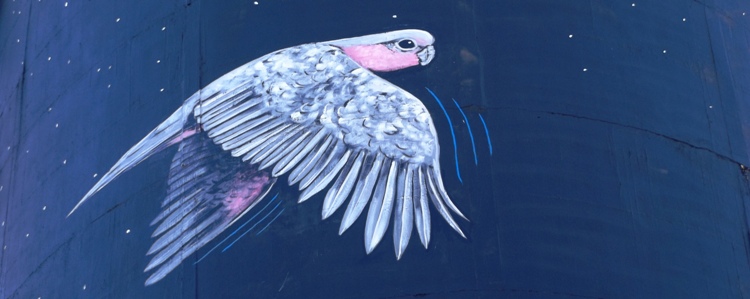
In 1818 John Oxley and his party passed through the area to the north of the town. Oxley noted: "Aboriginal bark huts were to be seen
in every direction along the Castlereagh River and with mussel shells in the fire places." George Evans, a member of the party reached
the river which he named the Castlereagh after Lord Castlereagh, the Secretary of State for the Colonies.
In 1840 James Walker established the first run in the area. He named his property 'Koonamble' taken from the Aboriginal name of ‘Gunambil'. It became a popular campsite for passing stockmen.
Land on the Castlereagh River was reserved for a townsite on 5 July,1855. In 1859
the townsite was surveyed and the first post office established and the town was officially gazetted in 1861.
